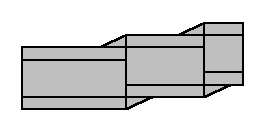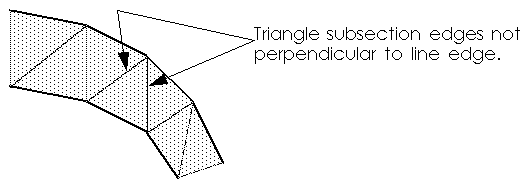Benchmarking
Evaluation of Electromagnetic Software
Revised: June 4, 1997
© Copyright 1994, 1999 Sonnet Software, Inc. All Rights Reserved
Table of Contents
Chapter 1 - Introduction
Chapter 2 - Technical Overview
Chapter 3 - The Stripline Standard
Chapter 4 - The Stripline Standard and Triangular Subsections
Chapter 5 - The Microstrip Standard
Chapter 6 - The Coupled Microstrip Standard
Chapter 7 - Limit Tests
Chapter 8 - Lossy Ground Plane and Lossy Dielectric Tests
Chapter 4 - The Stripline Standard and Triangular Subsections
Sonnet offers triangular subsections to allow current to flow along diagonal edges. Triangles of this sort are used to fill in the staircase edge which results when using rectangular subsections on a uniform mesh. This allows the edge current to flow naturally, parallel to the edge, see Figure 4. In all cases, edge current flows parallel to the edge of the metal, as is required for precision results.
However, there are electromagnetic analyses which use arbitrary size triangle subsections to represent current flowing through a smoothly curving transmission line, Figure 5. Depending on their implementation, such triangular subsections may force current to flow in an unnatural fashion, not strictly parallel to the edges of the metal. This is likely to be true if the triangles join together along boundaries which are not perpendicular to the transmission line edges.
This introduces an engineering trade-off. The arbitrary size triangles decrease analysis error by allowing a more accurate representation of curving edges. However, they increase error by forcing the current into an unnatural distribution. In order to make an engineering decision, we need to know how much error is caused by the triangles.
This is easily determined, as shown in Figure 6. Simply represent the Standard Stripline of the previous chapter in terms of triangles. Use the same kind of subsectioning as would be used for a curved line. Now, by analysis of the Standard Stripline subsectioned entirely into triangles, the error due to triangles may be determined precisely.

Figure 4. Sonnet uses triangle subsections to allow current to flow along diagonal edges, filling in the staircase formed by rectangular subsections.

Figure 5. Some electromagnetic analyses use arbitrary size triangle subsections to approximate the edges of smoothly curving structures. The key question is: What does this do to accuracy?

Figure 6. The error due to representing a transmission line entirely with triangles can be precisely characterized by subsectioning the Standard Stripline into triangles as shown above.
If the error due to triangle subsectioning can not be reduced to the vicinity of 1% or so, caution should be exercised as this could significantly reduce the probability of success on first fabrication. Be careful that the accuracy gained by being able to represent smoothly curving geometries is not all lost by the increased error generated by triangular subsections. Sonnet has not developed this type of subsection as the anticipated increase in error is deemed unacceptable.



